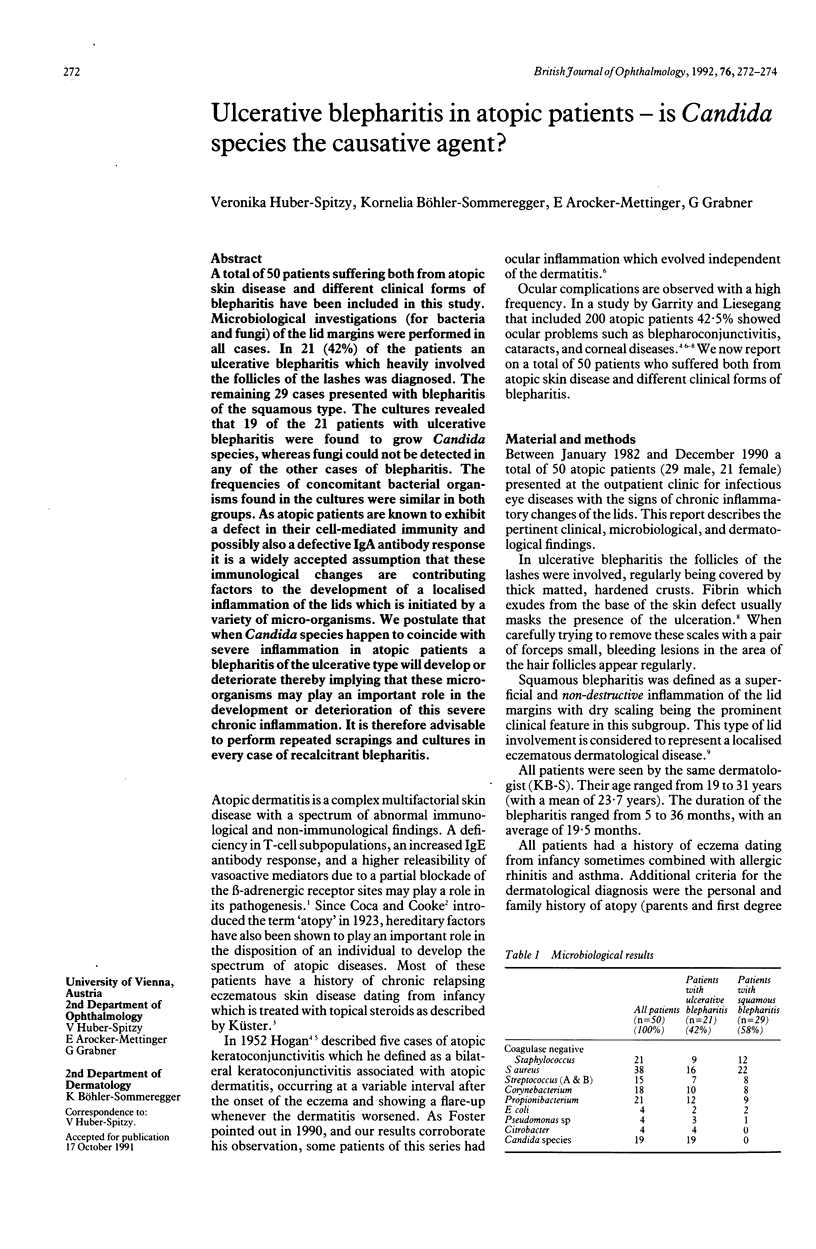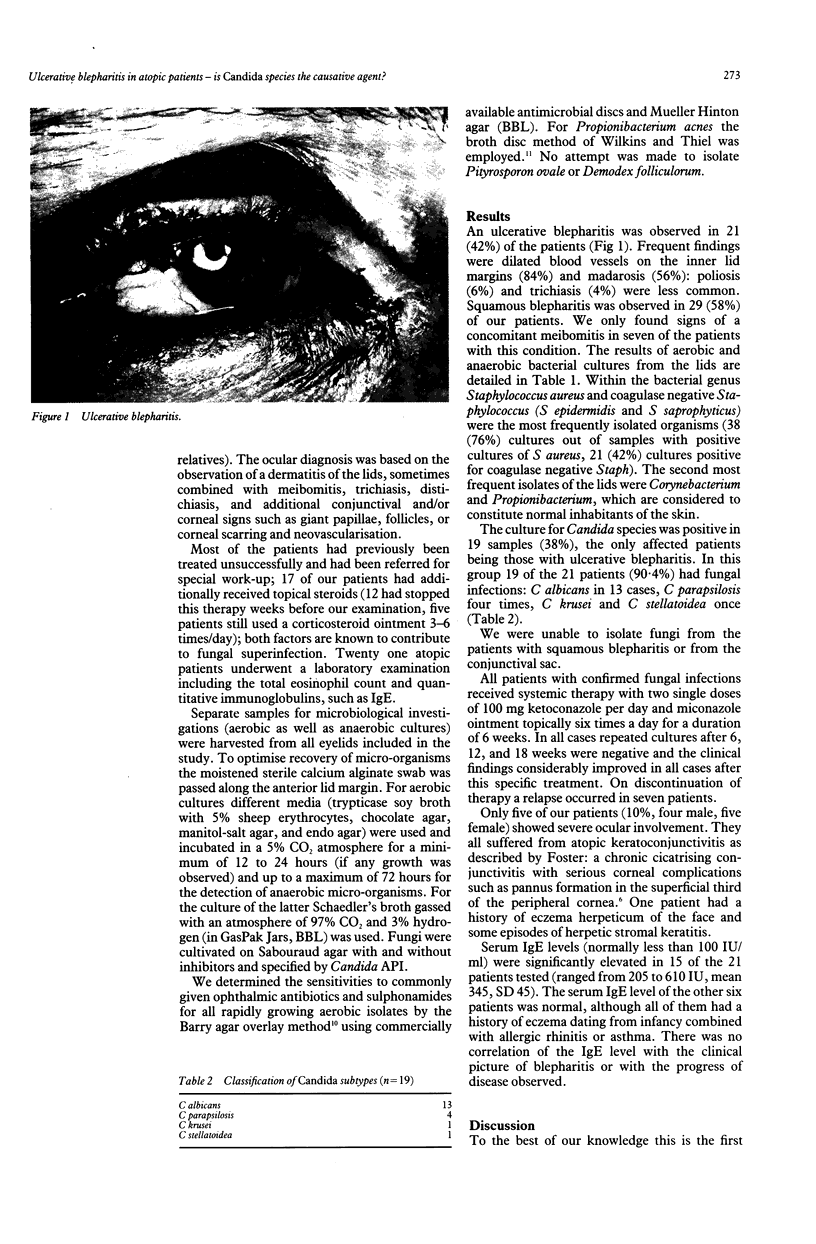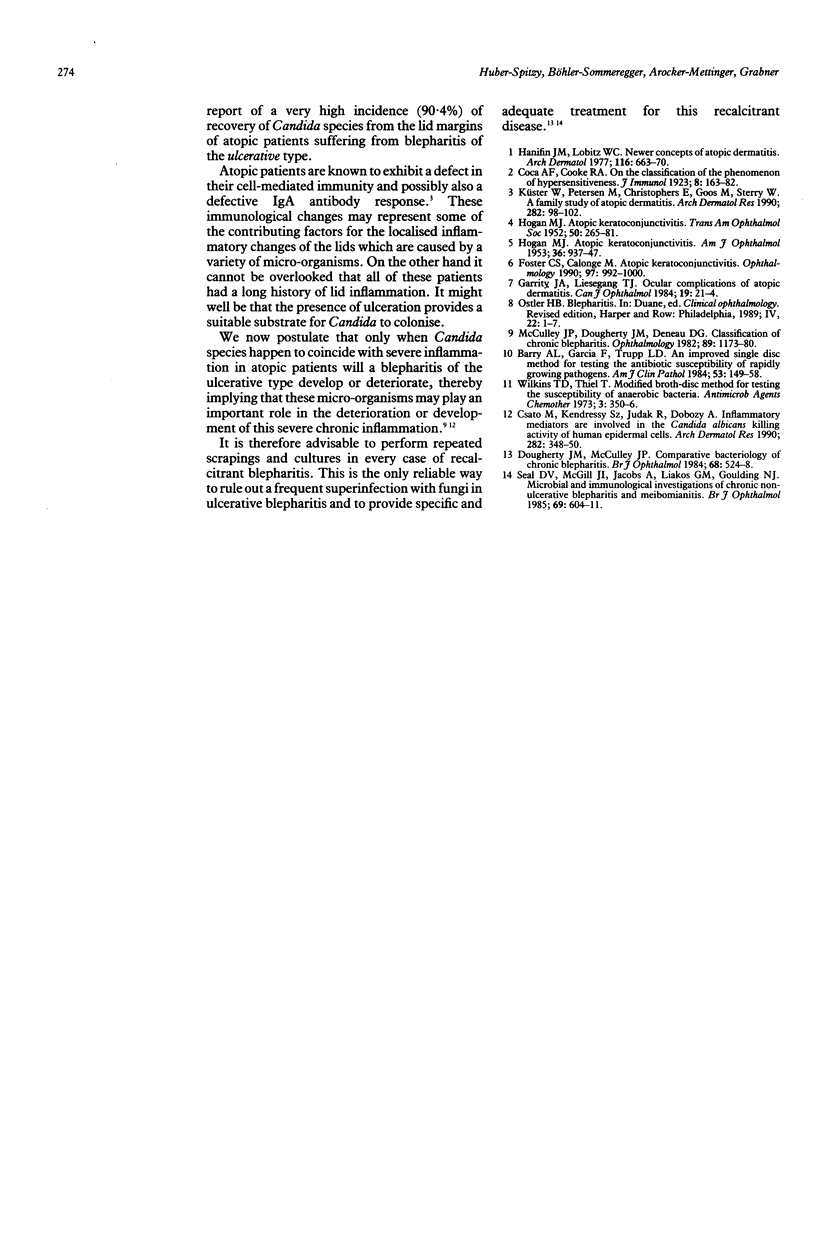Abstract
A total of 50 patients suffering both from atopic skin disease and different clinical forms of blepharitis have been included in this study. Microbiological investigations (for bacteria and fungi) of the lid margins were performed in all cases. In 21 (42%) of the patients an ulcerative blepharitis which heavily involved the follicles of the lashes was diagnosed. The remaining 29 cases presented with blepharitis of the squamous type. The cultures revealed that 19 of the 21 patients with ulcerative blepharitis were found to grow Candida species, whereas fungi could not be detected in any of the other cases of blepharitis. The frequencies of concomitant bacterial organisms found in the cultures were similar in both groups. As atopic patients are known to exhibit a defect in their cell-mediated immunity and possibly also a defective IgA antibody response it is a widely accepted assumption that these immunological changes are contributing factors to the development of a localised inflammation of the lids which is initiated by a variety of micro-organisms. We postulate that when Candida species happen to coincide with severe inflammation in atopic patients a blepharitis of the ulcerative type will develop or deteriorate thereby implying that these microorganisms may play an important role in the development or deterioration of this severe chronic inflammation. It is therefore advisable to perform repeated scrapings and cultures in every case of recalcitrant blepharitis.
Full text
PDF


Images in this article
Selected References
These references are in PubMed. This may not be the complete list of references from this article.
- Barry A. L., Garcia F., Thrupp L. D. An improved single-disk method for testing the antibiotic susceptibility of rapidly-growing pathogens. Am J Clin Pathol. 1970 Feb;53(2):149–158. doi: 10.1093/ajcp/53.2.149. [DOI] [PubMed] [Google Scholar]
- Csato M., Kenderessy A. S., Judák R., Dobozy A. Inflammatory mediators are involved in the Candida albicans killing activity of human epidermal cells. Arch Dermatol Res. 1990;282(5):348–350. doi: 10.1007/BF00375732. [DOI] [PubMed] [Google Scholar]
- Dougherty J. M., McCulley J. P. Comparative bacteriology of chronic blepharitis. Br J Ophthalmol. 1984 Aug;68(8):524–528. doi: 10.1136/bjo.68.8.524. [DOI] [PMC free article] [PubMed] [Google Scholar]
- Foster C. S., Calonge M. Atopic keratoconjunctivitis. Ophthalmology. 1990 Aug;97(8):992–1000. doi: 10.1016/s0161-6420(90)32477-6. [DOI] [PubMed] [Google Scholar]
- Garrity J. A., Liesegang T. J. Ocular complications of atopic dermatitis. Can J Ophthalmol. 1984 Feb;19(1):21–24. [PubMed] [Google Scholar]
- HOGAN M. J. Atopic keratoconjunctivitis. Am J Ophthalmol. 1953 Jul;36(7 1):937–947. doi: 10.1016/0002-9394(53)92176-x. [DOI] [PubMed] [Google Scholar]
- HOGAN M. J. Atopic keratoconjunctivitis. Trans Am Ophthalmol Soc. 1952;50:265–281. [PMC free article] [PubMed] [Google Scholar]
- Hanifin J. M., Lobitz W. C., Jr Newer concepts of atopic dermatitis. Arch Dermatol. 1977 May;113(5):663–670. [PubMed] [Google Scholar]
- Küster W., Petersen M., Christophers E., Goos M., Sterry W. A family study of atopic dermatitis. Clinical and genetic characteristics of 188 patients and 2,151 family members. Arch Dermatol Res. 1990;282(2):98–102. doi: 10.1007/BF00493466. [DOI] [PubMed] [Google Scholar]
- McCulley J. P., Dougherty J. M., Deneau D. G. Classification of chronic blepharitis. Ophthalmology. 1982 Oct;89(10):1173–1180. doi: 10.1016/s0161-6420(82)34669-2. [DOI] [PubMed] [Google Scholar]
- Seal D. V., McGill J. I., Jacobs P., Liakos G. M., Goulding N. J. Microbial and immunological investigations of chronic non-ulcerative blepharitis and meibomianitis. Br J Ophthalmol. 1985 Aug;69(8):604–611. doi: 10.1136/bjo.69.8.604. [DOI] [PMC free article] [PubMed] [Google Scholar]
- Wilkins T. D., Thiel T. Modified broth-disk method for testing the antibiotic susceptibility of anaerobic bacteria. Antimicrob Agents Chemother. 1973 Mar;3(3):350–356. doi: 10.1128/aac.3.3.350. [DOI] [PMC free article] [PubMed] [Google Scholar]



